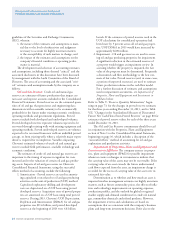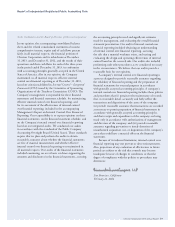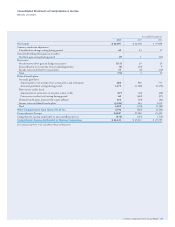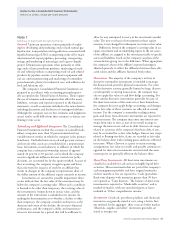Chevron 2013 Annual Report Download - page 27
Download and view the complete annual report
Please find page 27 of the 2013 Chevron annual report below. You can navigate through the pages in the report by either clicking on the pages listed below, or by using the keyword search tool below to find specific information within the annual report.Chevron Corporation 2013 Annual Report 25
discussion of impairments of properties, plant and equip-
ment in Note 9 beginning on page 41 and to the section on
Properties, Plant and Equipment in Note 1, “Summary of
Signicant Accounting Policies,” beginning on page 35.
No material individual impairments of PP&E or Invest-
ments were recorded for the three years ending December
31, 2013. A sensitivity analysis of the impact on earnings for
these periods if other assumptions had been used in impair-
ment reviews and impairment calculations is not practicable,
given the broad range of the company’s PP&E and the
number of assumptions involved in the estimates. at is,
favorable changes to some assumptions might have avoided
the need to impair any assets in these periods, whereas unfa-
vorable changes might have caused an additional unknown
number of other assets to become impaired.
Investments in common stock of aliates that are
accounted for under the equity method, as well as invest-
ments in other securities of these equity investees, are
reviewed for impairment when the fair value of the invest-
ment falls below the company’s carrying value. When such a
decline is deemed to be other than temporary, an impairment
charge is recorded to the income statement for the dierence
between the investment’s carrying value and its estimated fair
value at the time.
In making the determination as to whether a decline is
other than temporary, the company considers such factors as
the duration and extent of the decline, the investee’s nan-
cial performance, and the company’s ability and intention
to retain its investment for a period that will be sucient to
allow for any anticipated recovery in the investment’s mar-
ket value. Diering assumptions could aect whether an
investment is impaired in any period or the amount of the
impairment, and are not subject to sensitivity analysis.
From time to time, the company performs impairment
reviews and determines whether any write-down in the carry-
ing value of an asset or asset group is required. For example,
when signicant downward revisions to crude oil and natural
gas reserves are made for any single eld or concession, an
impairment review is performed to determine if the carrying
value of the asset remains recoverable. Also, if the expectation
of sale of a particular asset or asset group in any period has
been deemed more likely than not, an impairment review is
performed, and if the estimated net proceeds exceed the car-
rying value of the asset or asset group, no impairment charge
is required. Such calculations are reviewed each period until
the asset or asset group is disposed of. Assets that are not
impaired on a held-and-used basis could possibly become
impaired if a decision is made to sell such assets. at is, the
assets would be impaired if they are classied as held-for-sale
and the estimated proceeds from the sale, less costs to sell,
are less than the assets’ associated carrying values.
Asset Retirement Obligations In the determination
of fair value for an asset retirement obligation (ARO), the
company uses various assumptions and judgments, including
such factors as the existence of a legal obligation, estimated
amounts and timing of settlements, discount and ination
rates, and the expected impact of advances in technology
and process improvements. A sensitivity analysis of the
ARO impact on earnings for 2013 is not practicable, given
the broad range of the company’s long-lived assets and the
number of assumptions involved in the estimates. at is,
favorable changes to some assumptions would have reduced
estimated future obligations, thereby lowering accretion
expense and amortization costs, whereas unfavorable changes
would have the opposite eect. Refer to Note 24 on page 64
for additional discussions on asset retirement obligations.
Pension and Other Postretirement Benefit Plans
Note 21, beginning on page 56, includes information on the
funded status of the company’s pension and other postretire-
ment benet (OPEB) plans reected on the Consolidated
Balance Sheet; the components of pension and OPEB
expense reected on the Consolidated Statement of Income;
and the related underlying assumptions.
e determination of pension plan expense and obliga-
tions is based on a number of actuarial assumptions. Two
critical assumptions are the expected long-term rate of return
on plan assets and the discount rate applied to pension plan
obligations. Critical assumptions in determining expense and
obligations for OPEB plans, which provide for certain health
care and life insurance benets for qualifying retired employ-
ees and which are not funded, are the discount rate and the
assumed health care cost-trend rates. Information related
to the company’s processes to develop these assumptions is
included beginning on page 56 in Note 21 under the relevant
headings. Actual rates of return on plan assets and discount
rates may vary signicantly from estimates because of unan-
ticipated changes in the world’s nancial markets.
For 2013, the company used an expected long-term rate
of return of 7.5 percent and a discount rate of 3.6 percent for
U.S. pension plans. For the 10 years ending December 31,
2013, actual asset returns averaged 6.4 percent for the plan.
e actual return for 2013 was more than 7.5 percent and
was associated with a continuing recovery in the nancial
markets during the year. Additionally, with the exception
of two other years within this 10-year period, actual asset
returns for this plan equaled or exceeded 7.5 percent.
Total pension expense for 2013 was $1.3 billion. An
increase in the expected long-term return on plan assets or
the discount rate would reduce pension plan expense, and
vice versa. As an indication of the sensitivity of pension
expense to the long-term rate of return assumption, a
1 percent increase in this assumption for the company’s
primary U.S. pension plan, which accounted for 59 percent
of companywide pension expense, would have reduced
total pension plan expense for 2013 by approximately $85
million. A 1 percent increase in the discount rate for this
same plan would have reduced pension expense for 2013 by
approximately $190 million.
e aggregate funded status recognized at December
31, 2013, was a net liability of approximately $2.4 billion.
An increase in the discount rate would decrease the pension
obligation, thus changing the funded status of a plan. At
December 31, 2013, the company used a discount rate of
4.3 percent to measure the obligations for the U.S. pension
plans. As an indication of the sensitivity of pension liabilities
to the discount rate assumption, a 0.25 percent increase
























